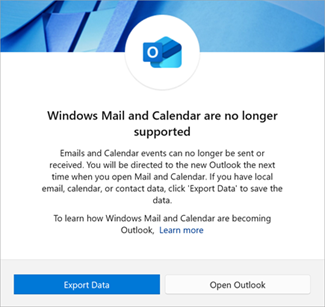Certain account types connected to the Windows Mail, Calendar, and People applications only save data locally. When you move to new Outlook, that data can be left behind unless you take specific actions to bring your data with you. This article shows you how to save data from the Mail, Calendar, and People applications and use it in new Outlook or any other email client.
In this article, learn how to:
Export emails and events from Windows Mail
Save and export emails and events from Windows Mail and Calendar
If you have a POP or IMAP account, or if you aren't using an account in Windows Mail, you can export and save your messages as .eml files and events as an .ics file and then import those messages and events to new Outlook.
-
In Search on the taskbar, type PowerShell and select Enter to open the app.
-
Copy the following code and paste it into Windows PowerShell window. Press Enter to run the script.
-
if (-not $env:USERPROFILE) {
$env:USERPROFILE = "C:\Users\$env:USERNAME" }
if (-not $env:LOCALAPPDATA) { $env:LOCALAPPDATA = "$env:USERPROFILE\AppData\Local" }
$directoryPath = "$env:LOCALAPPDATA\Packages\microsoft.windowscommunicationsapps_8wekyb3d8bbwe\LocalState\Migration"
$handoffFilePath = Join-Path -Path $directoryPath -ChildPath "handoff.txt" New-Item -ItemType File -Path $handoffFilePath -Force | Out-Null Start-Process "outlookmail:"
-
-
This open the Mail and Calendar app. On the Windows Mail and Calendar are no longer supported dialog, select Export Data.
-
File explorer opens to a new folder created on your device. In this new folder is an .ics file that contains all your local events, and one or more folders containing your local .eml messages. Make note of this file location because you'll need it if you choose to import your files to a new email application later.
Note: Only messages and events that are local to your device will be exported. Any messages or events that require online access (for example, the entire message hasn't downloaded yet), won't be exported. This is because those messages are available online and accessible via your existing POP or IMAP email account.
Save and export contacts from the Windows People app
You can export contacts you saved to the Windows People app and import them to new Outlook.
-
Follow instructions in the above section and select Export Data on the dialog in the Windows Mail and Calendar applications. The Windows People application will automatically open.
-
In the People app, select Download at the top of the People app.
-
In the Export all contacts window, select Export.
-
In the Save As window, select a location where you want to save your contacts. Select Save.
Tip: If you haven't already, you can download new Outlook from the Microsoft Store.
Import your emails to new Outlook
Note: Any email client that can open .eml files will be able to open these emails, though the instructions might be different.
You can import your email files to new Outlook. This step assumes you already added the account to new Outlook where you want to save these messages. If you haven't added an account, see Add an email account to Outlook.
-
In new Outlook, go to Settings > General > Import, and select Start import.The file explorer will open.
-
In file explorer, navigate to the location that your .eml files were saved and select Upload. Each folder will need to be imported individually.
-
Choose the account and folder you want to import the messages to and select Import.
Import your events to new Outlook
You can import your event files to new Outlook. This step assumes you already added the account to new Outlook where you want to save these events. If you haven't added an account, see Add an email account to Outlook.
-
In new Outlook, navigate to the Calendar .
-
On the left side of your window, select Add calendar.
-
Select Upload from filethen Browse.
-
Select the ICS file that you created and select Open.
-
Select which Calendar you would like to add the events to and select Import.
Import your contacts to new Outlook
Note: Any email client that can open .eml files will be able to open these emails though the instructions might be different.
-
From the navigation pane in new Outlook, select People.
-
Select the account you want the contacts imported to.
Note: You can now import your files to new Outlook. This step assumes you already added the account to new Outlook where you want to save these messages. If you haven't added an account, see Add an email account to Outlook.
-
Select Manage contacts > Import contacts.
-
Select Browse and select the .csv file that you saved.
-
Your contacts will be added to list of contacts for that account.
See also
Windows Mail, Calendar and People are becoming new Outlook











